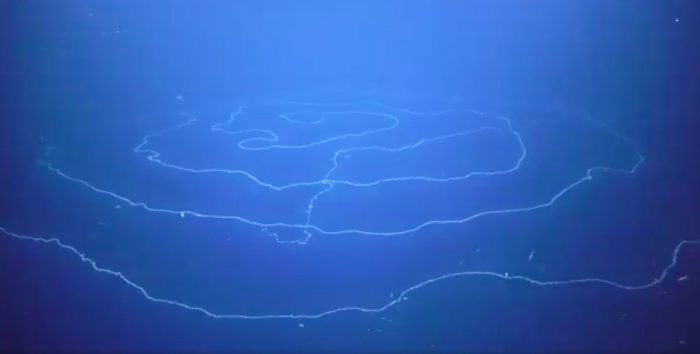Scientists love to be precise. It's kind of their thing.
And we appreciate their precision, even if it leaves us with long Latin-based names for creatures that we can't quite pronounce.
Sometimes, you just wish that they would go with something a bit more relatable and catchy. You know, like "long stringy stingy thingy". Then you know what you're dealing with!
Wait, hold on. Is that actually real?
It is! Scientists just discovered an extremely long stringy, stingy thingy off the coast of Western Australia.
Check out this beautiful *giant* siphonophore Apolemia recorded on #NingalooCanyons expedition. It seems likely that this specimen is the largest ever recorded, and in strange UFO-like feeding posture. Thanks @Caseywdunn for info @wamuseum @GeoscienceAus @CurtinUni @Scripps_Ocean pic.twitter.com/QirkIWDu6S
— Schmidt Ocean (@SchmidtOcean) April 6, 2020
Actually, it's a 'siphonophore'?
In truth, there is a scientific name for this type of organism. It is Apolemia uvaria, a kind of siphonophore.
Siphonophores are aquatic carnivores that share similarities to jellies. At first glance, they appear to be single creatures. But in fact, they are made up of hundreds, even thousands of tiny organisms called zooids. The zooids clone themselves over and over, until a living network is created called a colony. Like a colony of ants, different zooids serve different roles that help the entire group.
Some focus on reproduction. Some on moving. Others attract food with vivid lures that small fish mistake for food. And still others have stinging tentacles to capture prey. Siphonophores range greatly in size, but they are often like a chain.
That's why people in New Zealand and Australia call one a long stringy stingy thingy. It's perfect!
A true giant
Whatever you call them though, siphonophores aren't necessarily news. But a new international project called the Ningaloo Canyons Expedition put researchers in contact with one of the largest siphonophores ever seen. The outer ring is estimated to be around 47 metres (154 feet) long. That's about twice as long as the average blue whale.
And that's just the outer ring. This long stringy stingy thingy curls in around itself several times over, making it many times that length. Though you can't call it the largest 'animal' since it is many organisms group together, it is still really, really something.
This tweet from biologist Rebecca Helm puts it into perspective.
...most of the siphonophore colonies I've seen are maybe a 20cm long, maybe a meter. But THIS animal is massive. AND not just massive, the colony is exhibiting a stunning behavior: it's hunting....
— Open Ocean Exploration (@RebeccaRHelm) April 6, 2020
So should we be scared? Well, one thing is for sure... it's not hunting you. So that's a relief! But it is a spectacular example of the variety of life in the ocean. And just how much more there still is to discover down there. And name!
 Though not a single animal, this is still a stunning collection of life. (Twitter/Schmidt Ocean)
Though not a single animal, this is still a stunning collection of life. (Twitter/Schmidt Ocean)










Just so weird.